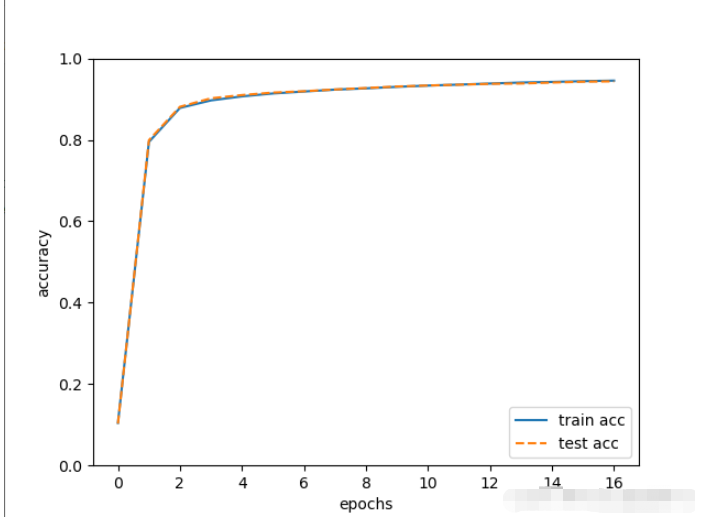溫馨提示×
您好,登錄后才能下訂單哦!
點擊 登錄注冊 即表示同意《億速云用戶服務條款》
您好,登錄后才能下訂單哦!
本篇內容介紹了“純numpy數值微分法如何實現手寫數字識別”的有關知識,在實際案例的操作過程中,不少人都會遇到這樣的困境,接下來就讓小編帶領大家學習一下如何處理這些情況吧!希望大家仔細閱讀,能夠學有所成!
程序分為兩部分,首先是手寫數字數據的準備,直接使用如下mnist.py文件中的方法load_minist即可。文件代碼如下:
# coding: utf-8
try:
import urllib.request
except ImportError:
raise ImportError('You should use Python 3.x')
import os.path
import gzip
import pickle
import os
import numpy as np
url_base = 'http://yann.lecun.com/exdb/mnist/'
key_file = {
'train_img':'train-images-idx3-ubyte.gz',
'train_label':'train-labels-idx1-ubyte.gz',
'test_img':'t10k-images-idx3-ubyte.gz',
'test_label':'t10k-labels-idx1-ubyte.gz'
}
dataset_dir = os.path.dirname(os.path.abspath(__file__))
save_file = dataset_dir + "/mnist.pkl"
train_num = 60000
test_num = 10000
img_dim = (1, 28, 28)
img_size = 784
def _download(file_name):
file_path = dataset_dir + "/" + file_name
if os.path.exists(file_path):
return
print("Downloading " + file_name + " ... ")
urllib.request.urlretrieve(url_base + file_name, file_path)
print("Done")
def download_mnist():
for v in key_file.values():
_download(v)
def _load_label(file_name):
file_path = dataset_dir + "/" + file_name
print("Converting " + file_name + " to NumPy Array ...")
with gzip.open(file_path, 'rb') as f:
labels = np.frombuffer(f.read(), np.uint8, offset=8)
print("Done")
return labels
def _load_img(file_name):
file_path = dataset_dir + "/" + file_name
print("Converting " + file_name + " to NumPy Array ...")
with gzip.open(file_path, 'rb') as f:
data = np.frombuffer(f.read(), np.uint8, offset=16)
data = data.reshape(-1, img_size)
print("Done")
return data
def _convert_numpy():
dataset = {}
dataset['train_img'] = _load_img(key_file['train_img'])
dataset['train_label'] = _load_label(key_file['train_label'])
dataset['test_img'] = _load_img(key_file['test_img'])
dataset['test_label'] = _load_label(key_file['test_label'])
return dataset
def init_mnist():
download_mnist()
dataset = _convert_numpy()
print("Creating pickle file ...")
with open(save_file, 'wb') as f:
pickle.dump(dataset, f, -1)
print("Done!")
def _change_one_hot_label(X):
T = np.zeros((X.size, 10))
for idx, row in enumerate(T):
row[X[idx]] = 1
return T
def load_mnist(normalize=True, flatten=True, one_hot_label=False):
"""讀入MNIST數據集
Parameters
----------
normalize : 將圖像的像素值正規化為0.0~1.0
one_hot_label :
one_hot_label為True的情況下,標簽作為one-hot數組返回
one-hot數組是指[0,0,1,0,0,0,0,0,0,0]這樣的數組
flatten : 是否將圖像展開為一維數組
Returns
-------
(訓練圖像, 訓練標簽), (測試圖像, 測試標簽)
"""
if not os.path.exists(save_file):
init_mnist()
with open(save_file, 'rb') as f:
dataset = pickle.load(f)
if normalize:
for key in ('train_img', 'test_img'):
dataset[key] = dataset[key].astype(np.float32)
dataset[key] /= 255.0
if one_hot_label:
dataset['train_label'] = _change_one_hot_label(dataset['train_label'])
dataset['test_label'] = _change_one_hot_label(dataset['test_label'])
if not flatten:
for key in ('train_img', 'test_img'):
dataset[key] = dataset[key].reshape(-1, 1, 28, 28)
return (dataset['train_img'], dataset['train_label']), (dataset['test_img'], dataset['test_label'])
if __name__ == '__main__':
init_mnist()使用上述文件中的函數就可以直接得到手寫數字的訓練數據、訓練標簽,測試樣本以及測試標簽。
接下里使用如下代碼就可以進行手寫數字的訓練,代碼如下:
import numpy as np
from numpy.lib.function_base import select
from dataset.mnist import load_mnist
import matplotlib.pylab as plt
def sigmoid(x):
return 1 / (1 + np.exp(-x))
def sigmoid_grad(x):
return (1.0 - sigmoid(x)) * sigmoid(x)
def softmax(x):
if x.ndim == 2:
x = x.T
x = x - np.max(x, axis=0)
y = np.exp(x) / np.sum(np.exp(x), axis=0)
return y.T
x = x - np.max(x) # 溢出對策
return np.exp(x) / np.sum(np.exp(x))
def cross_entropy_error(y, t):
if y.ndim == 1:
t = t.reshape(1, t.size)
y = y.reshape(1, y.size)
# 監督數據是one-hot-vector的情況下,轉換為正確解標簽的索引
if t.size == y.size:
t = t.argmax(axis=1)
batch_size = y.shape[0]
return -np.sum(np.log(y[np.arange(batch_size), t] + 1e-7)) / batch_size
def numerical_gradient(f, x):
h = 1e-4 # 0.0001
grad = np.zeros_like(x)
it = np.nditer(x, flags=['multi_index'], op_flags=['readwrite'])
while not it.finished:
idx = it.multi_index
tmp_val = x[idx]
x[idx] = float(tmp_val) + h
fxh2 = f(x) # f(x+h)
x[idx] = tmp_val - h
fxh3 = f(x) # f(x-h)
grad[idx] = (fxh2 - fxh3) / (2*h)
x[idx] = tmp_val # 還原值
it.iternext()
return grad
#(x_train,t_train),(x_test,t_test)=load_mnist(normalize=True,one_hot_label=True)
#兩層神經網絡的類
class TwoLayerNet:
def __init__(self,input_size,hidden_size,output_size,weight_init_std=0.01):
#初始化權重
self.params={}
self.params['W1']=weight_init_std*np.random.randn(input_size,hidden_size)
self.params['b1']=np.zeros(hidden_size)
self.params['W2']=weight_init_std*np.random.randn(hidden_size,output_size)
self.params['b2']=np.zeros(output_size)
def predict(self,x):
W1,W2=self.params['W1'],self.params['W2']
b1,b2=self.params['b1'],self.params['b2']
a1=np.dot(x,W1)+b1
z1=sigmoid(a1)
a2=np.dot(z1,W2)+b2
y=softmax(a2)
return y
#損失函數
def loss(self,x,t):
y=self.predict(x)
return cross_entropy_error(y,t)
#數值微分法
def numerical_gradient(self,x,t):
loss_W=lambda W:self.loss(x,t)
grads={}
grads['W1']=numerical_gradient(loss_W,self.params['W1'])
grads['b1']=numerical_gradient(loss_W,self.params['b1'])
grads['W2']=numerical_gradient(loss_W,self.params['W2'])
grads['b2']=numerical_gradient(loss_W,self.params['b2'])
return grads
#誤差反向傳播法
def gradient(self, x, t):
W1, W2 = self.params['W1'], self.params['W2']
b1, b2 = self.params['b1'], self.params['b2']
grads = {}
batch_num = x.shape[0]
# forward
a1 = np.dot(x, W1) + b1
z1 = sigmoid(a1)
a2 = np.dot(z1, W2) + b2
y = softmax(a2)
# backward
dy = (y - t) / batch_num
grads['W2'] = np.dot(z1.T, dy)
grads['b2'] = np.sum(dy, axis=0)
da1 = np.dot(dy, W2.T)
dz1 = sigmoid_grad(a1) * da1
grads['W1'] = np.dot(x.T, dz1)
grads['b1'] = np.sum(dz1, axis=0)
return grads
#準確率
def accuracy(self,x,t):
y=self.predict(x)
y=np.argmax(y,axis=1)
t=np.argmax(t,axis=1)
accuracy=np.sum(y==t)/float(x.shape[0])
return accuracy
if __name__=='__main__':
(x_train,t_train),(x_test,t_test)=load_mnist(normalize=True,one_hot_label=True)
net=TwoLayerNet(input_size=784,hidden_size=50,output_size=10)
train_loss_list=[]
#超參數
iter_nums=10000
train_size=x_train.shape[0]
batch_size=100
learning_rate=0.1
#記錄準確率
train_acc_list=[]
test_acc_list=[]
#平均每個epoch的重復次數
iter_per_epoch=max(train_size/batch_size,1)
for i in range(iter_nums):
#小批量數據
batch_mask=np.random.choice(train_size,batch_size)
x_batch=x_train[batch_mask]
t_batch=t_train[batch_mask]
#計算梯度
#數值微分 計算很慢
#grad=net.numerical_gradient(x_batch,t_batch)
#誤差反向傳播法 計算很快
grad=net.gradient(x_batch,t_batch)
#更新參數 權重W和偏重b
for key in ['W1','b1','W2','b2']:
net.params[key]-=learning_rate*grad[key]
#記錄學習過程
loss=net.loss(x_batch,t_batch)
print('訓練次數:'+str(i)+' loss:'+str(loss))
train_loss_list.append(loss)
#計算每個epoch的識別精度
if i%iter_per_epoch==0:
#測試在所有訓練數據和測試數據上的準確率
train_acc=net.accuracy(x_train,t_train)
test_acc=net.accuracy(x_test,t_test)
train_acc_list.append(train_acc)
test_acc_list.append(test_acc)
print('train acc:'+str(train_acc)+' test acc:'+str(test_acc))
print(train_acc_list)
print(test_acc_list)
# 繪制圖形
markers = {'train': 'o', 'test': 's'}
x = np.arange(len(train_acc_list))
plt.plot(x, train_acc_list, label='train acc')
plt.plot(x, test_acc_list, label='test acc', linestyle='--')
plt.xlabel("epochs")
plt.ylabel("accuracy")
plt.ylim(0, 1.0)
plt.legend(loc='lower right')
plt.show()訓練完成后,查看繪制準確率的圖片,可以獲取到成功實現了手寫數字識別。

隨著訓練批次的增加,準確率逐漸增大接近于1,說明訓練過程按著正確擬合的方向前進。
“純numpy數值微分法如何實現手寫數字識別”的內容就介紹到這里了,感謝大家的閱讀。如果想了解更多行業相關的知識可以關注億速云網站,小編將為大家輸出更多高質量的實用文章!
免責聲明:本站發布的內容(圖片、視頻和文字)以原創、轉載和分享為主,文章觀點不代表本網站立場,如果涉及侵權請聯系站長郵箱:is@yisu.com進行舉報,并提供相關證據,一經查實,將立刻刪除涉嫌侵權內容。